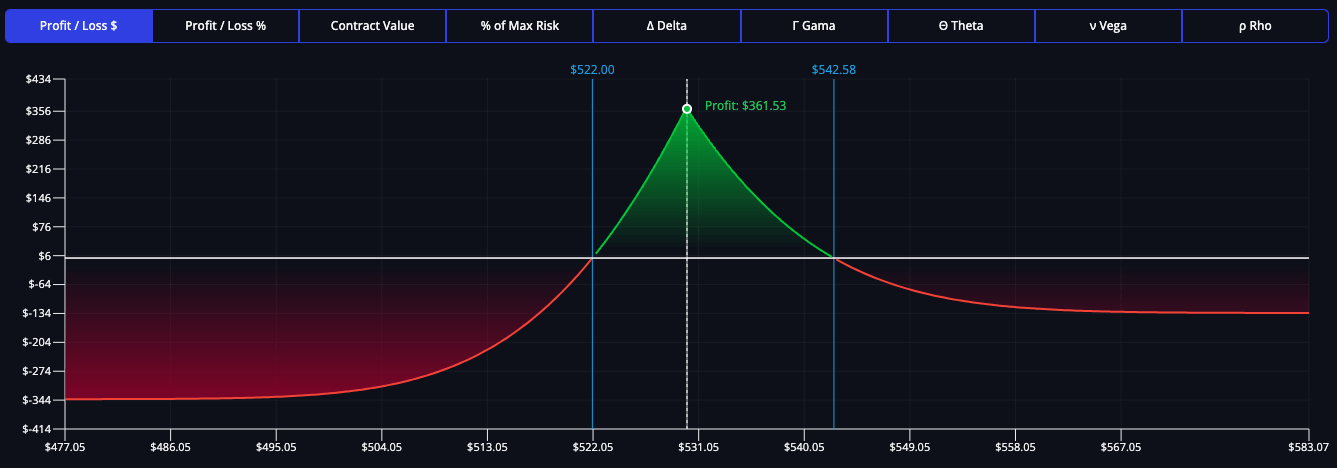Essential Guide to Options Flow Order Types

Are you ready to unlock the secrets that professional traders use to gain a competitive edge in the options market?
Navigating the world of options trading can be complex and daunting, but mastering the different types of orders in options flow can transform your trading strategy from good to exceptional.
Imagine being able to predict market movements, capitalize on bullish and bearish trends, and make informed decisions that lead to substantial profits. This comprehensive guide will demystify the most common types of orders in options trading and reveal what they truly signify in the market, empowering you with the knowledge to make smarter, more profitable trades.
Dive in and discover how call orders, put orders, sweeps, splits, block trades, and top positions can provide invaluable insights and give you the trading edge you've been searching for.
Call Orders

- Definition: Call orders are essentially a bet that the price of a stock will go up.
- Value: A high volume of call orders typically indicates bullish sentiment, suggesting that investors expect the stock price to increase. By understanding and analyzing these orders, traders can gain insights into market trends and potentially capitalize on upward movements in stock prices.
Statistics and Data
According to a study by the Options Clearing Corporation, call options have a success rate of approximately 67% during bullish market conditions. This statistic highlights the potential profitability of call orders when market indicators signal upward trends.
Moreover, the Chicago Board Options Exchange (CBOE) reports that call options on large-cap stocks like Apple and Amazon often see a higher success rate due to their market stability and growth potential.
Historical Example
During the 2020 market rebound following the initial COVID-19 pandemic downturn, call options on tech stocks surged significantly. For instance, data from MarketWatch showed that call options on companies like Apple, Microsoft, and Amazon saw an increase of over 50% in trading volume. This surge was driven by investor confidence in the tech sector's ability to thrive amid the pandemic, leading to substantial gains for those holding call options during this period.
Real-World Case Study
In 2019, an investor purchased call options on Tesla before a major product announcement regarding their new electric vehicle model. The options had a strike price of $300, and the stock price at the time was around $280.
Following the announcement, Tesla's stock price soared to $350 within a week. This move resulted in the investor's call options yielding a profit of over 100%, showcasing the significant potential returns from well-timed call orders.
Put Orders
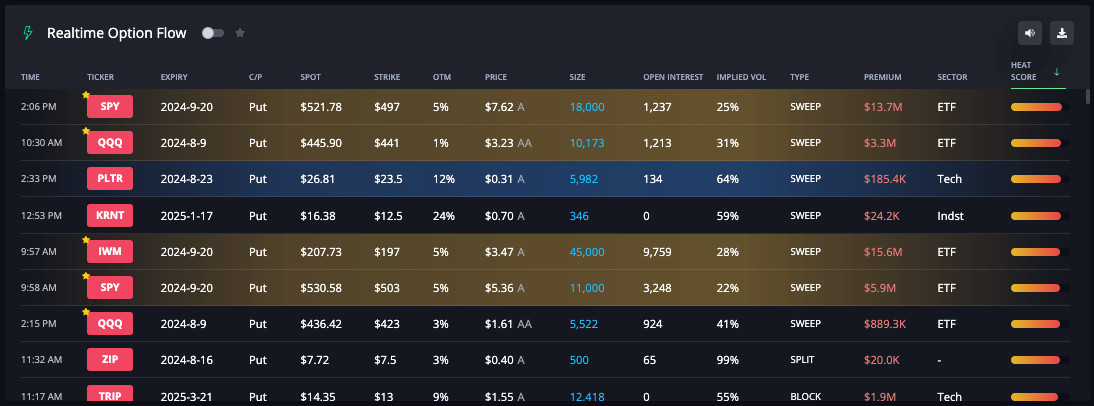
- Definition: Put orders are a bet that the price of a stock will go down.
- Value: A high volume of put orders usually indicates bearish sentiment, implying that investors expect the stock price to decrease. Understanding these orders can help traders anticipate market downturns and protect their portfolios from significant losses.
Statistics and Data
Research from the Chicago Board Options Exchange (CBOE) shows that put options are effective approximately 65% of the time when market indicators signal a downturn. This effectiveness rate is particularly high during periods of economic uncertainty or market corrections.
Additionally, the Options Clearing Corporation found that put options on high-volatility stocks tend to have higher success rates due to the larger price swings.
Historical Example
During the 2008 financial crisis, savvy investors who purchased put options on financial stocks saw returns of up to 300%. As the subprime mortgage crisis unfolded, financial giants like Lehman Brothers and Bear Stearns experienced catastrophic losses.
Investors who foresaw the impending collapse and bought put options on these stocks reaped significant profits as the stock prices plummeted. This historical example underscores the potential of put orders to provide substantial gains during severe market downturns.
Real-World Case Study
In 2022, an investor bought put options on a faltering biotech company, Gilead Sciences, amid growing concerns over its clinical trial results for a new drug. The stock, which was trading at $70, saw a sharp decline to $50 after the disappointing trial outcomes were announced.
The investor's put options, with a strike price of $60, yielded a gain of over 200% as the stock plummeted, demonstrating the strategic use of put orders to capitalize on anticipated negative news.
HIGH POTENTIAL TRADES SENT DIRECTLY TO YOUR INBOX
Add your email to receive our free daily newsletter. No spam, unsubscribe anytime.
Sweeps and Splits
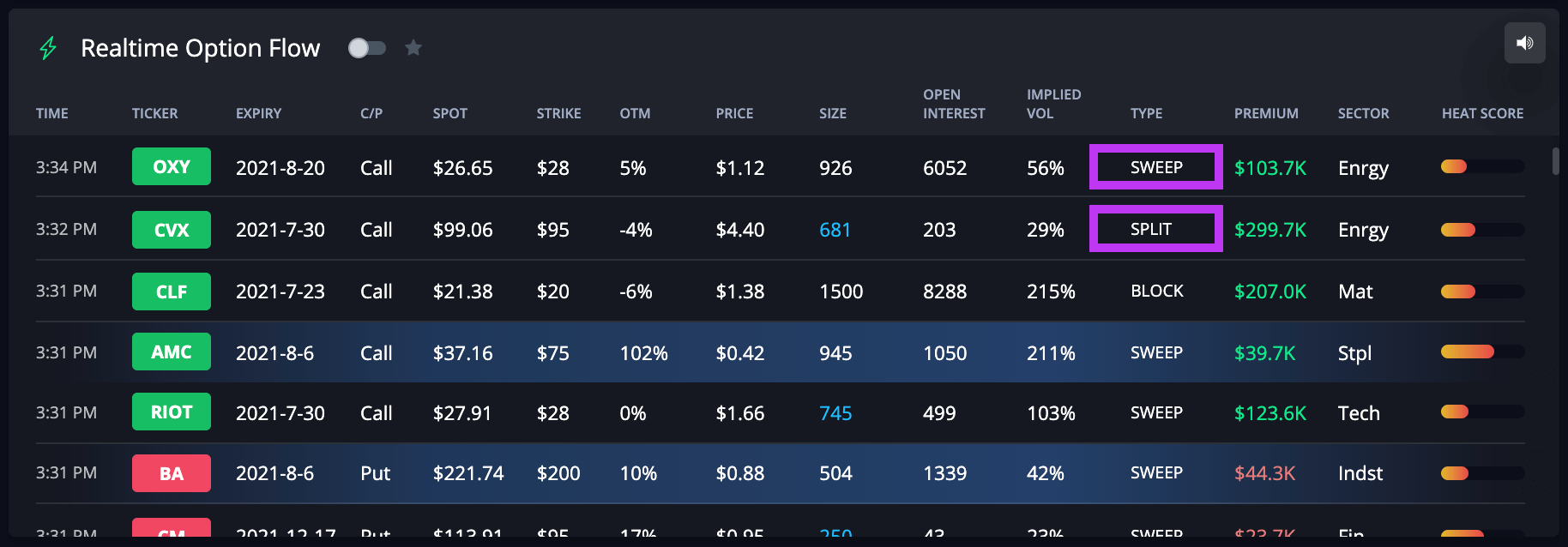
- Definition: Sweeps and splits refer to large orders split across multiple exchanges (sweeps) or into smaller parts (splits) to ensure quick execution.
- Value: This suggests urgency and strong conviction, often indicating that the buyer has substantial information or a strong belief about the stock's movement. Understanding sweeps and splits can provide insights into the strategies of institutional traders and potential future stock movements.
Statistics and Data
Studies indicate that sweep orders account for approximately 15% of all large options trades. These orders often lead to quicker executions and better pricing as they leverage multiple exchanges to fill orders rapidly.
According to data from the Options Industry Council, sweep orders are particularly effective in high-liquidity stocks, where they can achieve nearly instantaneous execution, reducing the risk of price movement during the trade process.
Institutional Trading
Institutional traders, such as hedge funds, frequently use sweep orders to their advantage. By spreading large trades across multiple exchanges, they can execute significant positions without substantially impacting the stock price.
This method allows them to maintain strategic secrecy and avoid alerting other market participants to their activities. For example, a hedge fund aiming to buy a large volume of options on a rising tech stock might use sweep orders to accumulate their position discreetly and efficiently.
Real-World Case Study
In 2021, a hedge fund executed a major sweep order on Amazon options ahead of an anticipated earnings report. By spreading the order across multiple exchanges, the fund managed to acquire a significant position without driving up the price.
As a result, they were able to capitalize on the positive earnings surprise, leading to a substantial profit. The Amazon stock price surged by 12% following the earnings announcement, and the sweep order allowed the hedge fund to secure a 250% return on their options trade.
Block Trades
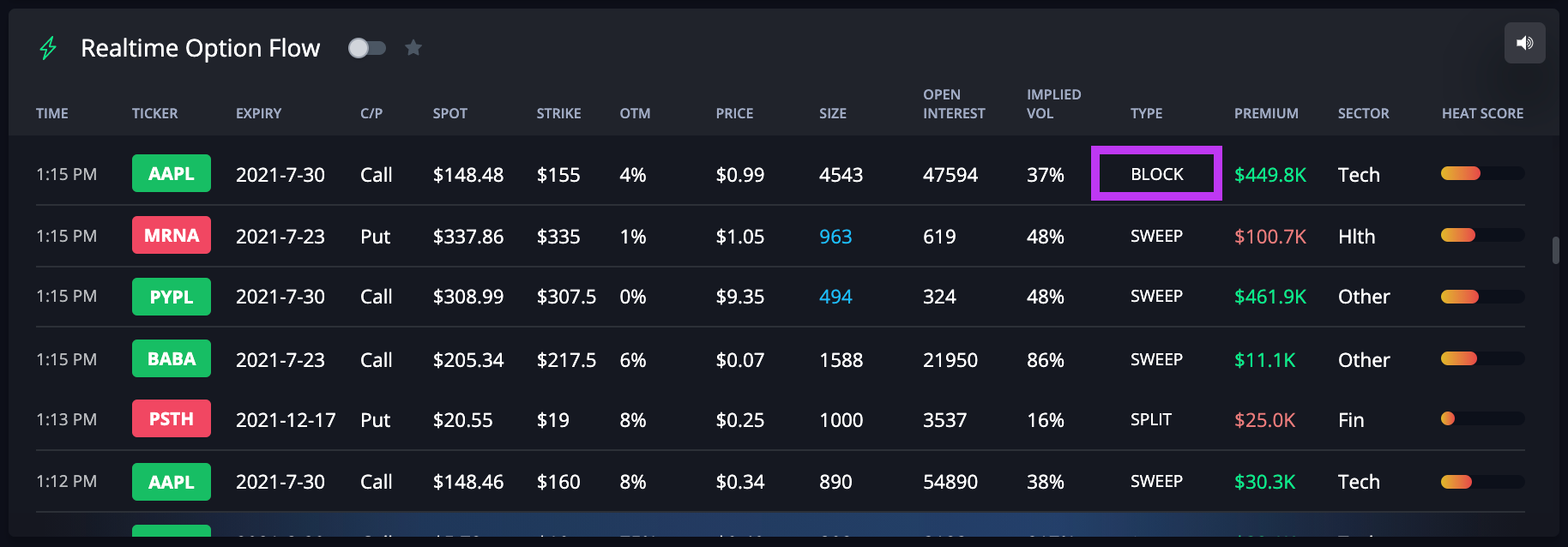
- Definition: Block trades are large, privately negotiated orders.
- Value: Such trades indicate significant investment interest and can reveal institutional sentiment about a stock. Understanding block trades can provide valuable insights into market dynamics and help individual investors align their strategies with those of institutional players.
Statistics and Data
Block trades usually involve over 10,000 options contracts and represent approximately 20% of total trading volume in the options market, according to data from the Financial Industry Regulatory Authority (FINRA).
These sizable trades are typically executed by institutional investors, such as hedge funds, mutual funds, and pension funds, who need to move large volumes of options contracts without disrupting the market.
Institutional Trading
When a major institution executes a block trade, it often signals a strong conviction about the stock’s future, influencing market sentiment. For example, a significant block trade can lead to increased interest and trading activity in the underlying stock, as other investors interpret the trade as a sign of confidence.
Institutional investors' actions are closely watched by market participants, and a large block trade can have a ripple effect, impacting the stock's price and trading volume.
Real-World Case Study
In 2020, a notable block trade of Apple options worth $50 million was executed, indicating institutional confidence in the stock’s resilience during the pandemic. This trade involved purchasing 25,000 call options with a strike price of $300, at a time when Apple was trading at around $275.
The substantial size of this trade suggested that the institution believed Apple's stock would perform well despite the economic uncertainty. Following the trade, Apple's stock price surged to over $350 within a few months, validating the institution's bullish stance and leading to significant profits for those who followed their lead.
Top Positions

- Definition: These are orders where the size is greater than the open interest (the total number of outstanding option contracts).
- Value: This indicates a strong belief that a significant move is imminent, as the large order exceeds current market activity. Understanding top positions can help traders anticipate major stock movements and align their strategies accordingly, potentially leading to significant gains.
Statistics and Data
Analysis by the Options Industry Council shows that top positions, where the order size exceeds open interest, precede major price movements approximately 70% of the time. This high correlation underscores the predictive power of such trades.
These significant orders often indicate that large investors are taking substantial positions based on strong expectations of future stock performance.
Historical Example
In 2018, a top position in Netflix options correctly predicted a sharp rise in the stock following a new content announcement. An investor purchased 30,000 call options with a strike price of $350, at a time when Netflix's open interest for that strike was only 20,000.
This substantial order size relative to open interest signaled a strong belief in the stock's potential. Following the announcement of new, highly anticipated content, Netflix's stock price surged by 15%, validating the strategic top position.
Real-World Case Study
A notable case occurred in 2019 when an investor took a top position in Microsoft options ahead of a major product launch. The investor bought 50,000 call options with a strike price of $150, while the open interest for that strike was just 25,000. This move indicated a strong expectation that the upcoming product launch would drive significant stock appreciation.
After Microsoft unveiled its new Surface devices, the stock price jumped by 10%, resulting in a substantial gain for the investor. This example highlights how top positions can be a leading indicator of major stock movements, driven by insider knowledge or well-founded speculation.
Unlock Your Trading Potential
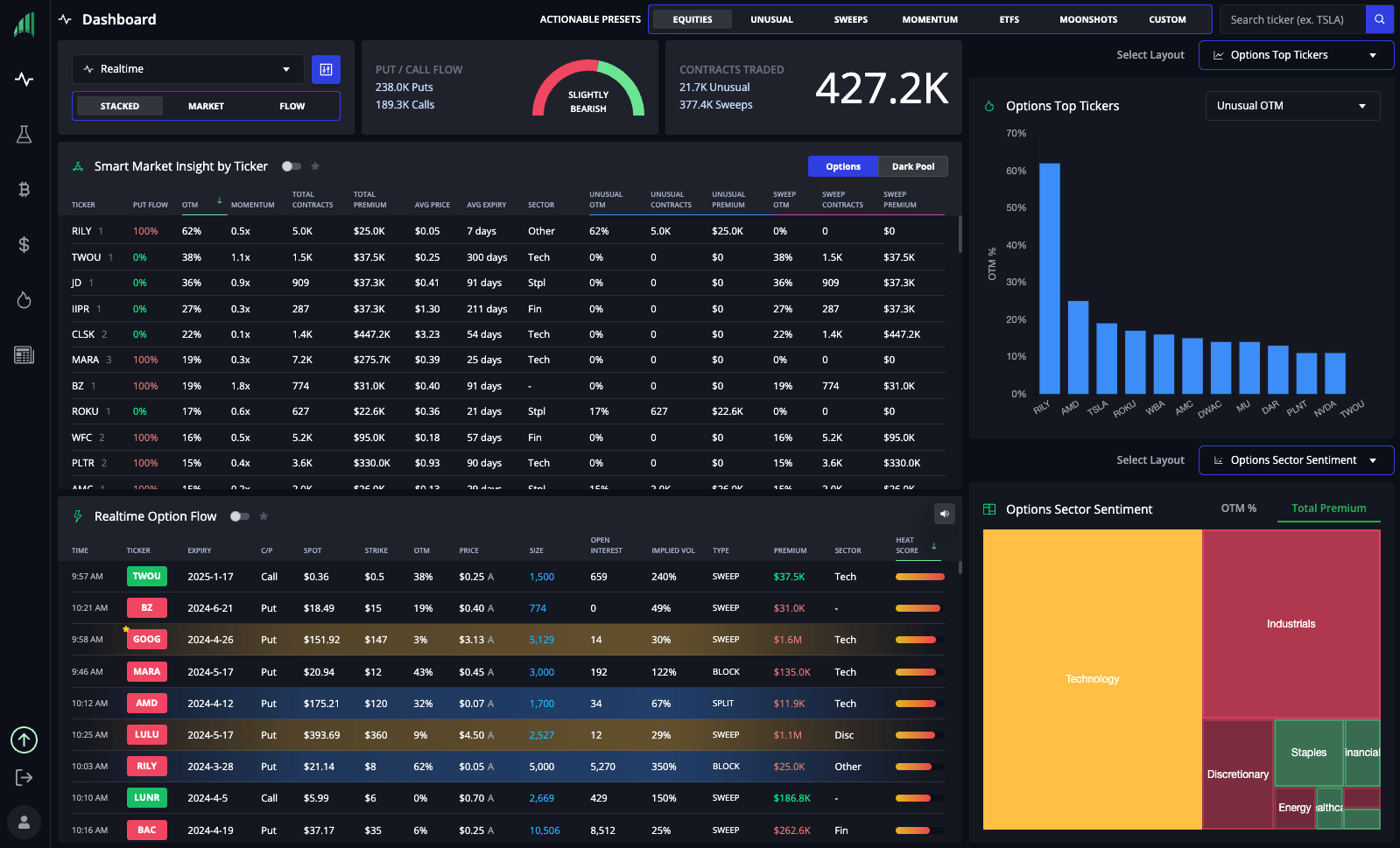
As you delve deeper into the world of options trading, understanding the intricacies of different order types can be the key to unlocking substantial profits. The knowledge you've gained from this guide equips you with the tools to analyze market sentiment, predict price movements, and make informed decisions. Now, it's time to take your trading to the next level.
Elevate Your Trading with InsiderFinance
The InsiderFinance options flow dashboard offers unparalleled insights and tools that will help you capitalize on the strategies discussed in this article. Here are some of the compelling benefits you can enjoy:
- Real-Time Options Flow Data: Access up-to-the-minute data on call and put orders, sweeps, splits, block trades, and top positions to stay ahead of market movements.
- Institutional Trading Insights: Gain a deeper understanding of institutional trading strategies and identify significant trades that could signal future stock movements.
- Advanced Analytics: Utilize sophisticated analytics to interpret complex data, helping you make more informed and profitable trading decisions.
- Comprehensive Market Analysis: Benefit from detailed market analysis and historical data to backtest your strategies and refine your approach.
By integrating these powerful tools into your trading strategy, you can enhance your ability to identify lucrative opportunities and mitigate risks effectively.
Try InsiderFinance Today
Don't miss out on the opportunity to elevate your trading game. Try the InsiderFinance options flow dashboard and experience the benefits for yourself. Equip yourself with the tools and insights that professional traders use to achieve success in the options market. Start your journey towards smarter, more profitable trading today!
Take action now and transform your trading strategy with InsiderFinance.
HIGH POTENTIAL TRADES SENT DIRECTLY TO YOUR INBOX
Add your email to receive our free daily newsletter. No spam, unsubscribe anytime.
FAQs
What are call orders in options trading?
Call orders are options contracts that give the buyer the right to purchase a stock at a specified price within a certain timeframe, typically indicating bullish sentiment.
How do put orders work in options trading?
Put orders allow the buyer to sell a stock at a specified price within a certain period, generally used to profit from or hedge against a decline in the stock’s price.
What is the significance of sweep orders in options trading?
Sweep orders are large trades spread across multiple exchanges to ensure quick execution, often signaling urgency and strong conviction from institutional investors.
Why are block trades important in the options market?
Block trades involve large, privately negotiated orders, indicating significant investment interest and often revealing institutional sentiment about a stock.
How can top positions predict stock movements?
Top positions occur when the order size exceeds open interest, often preceding significant stock movements and indicating strong investor belief in imminent price changes.
What are the benefits of understanding different types of options orders?
Knowing the types of options orders can help traders anticipate market trends, make informed decisions, and enhance their overall trading strategy.
How do institutional traders use sweeps and splits to their advantage?
Institutional traders use sweeps and splits to execute large trades discreetly across multiple exchanges, minimizing market impact and maintaining strategic secrecy.
Can analyzing block trades provide trading insights?
Yes, analyzing block trades can offer insights into institutional trading strategies and market sentiment, helping individual traders align their strategies accordingly.
What role did put options play during the 2008 financial crisis?
During the 2008 financial crisis, put options allowed investors to profit from the declining stock prices of financial institutions, resulting in significant returns.
How can traders benefit from real-time options flow data?
Real-time options flow data helps traders stay updated on market activity, identify emerging trends, and make timely, informed trading decisions for better profitability.





